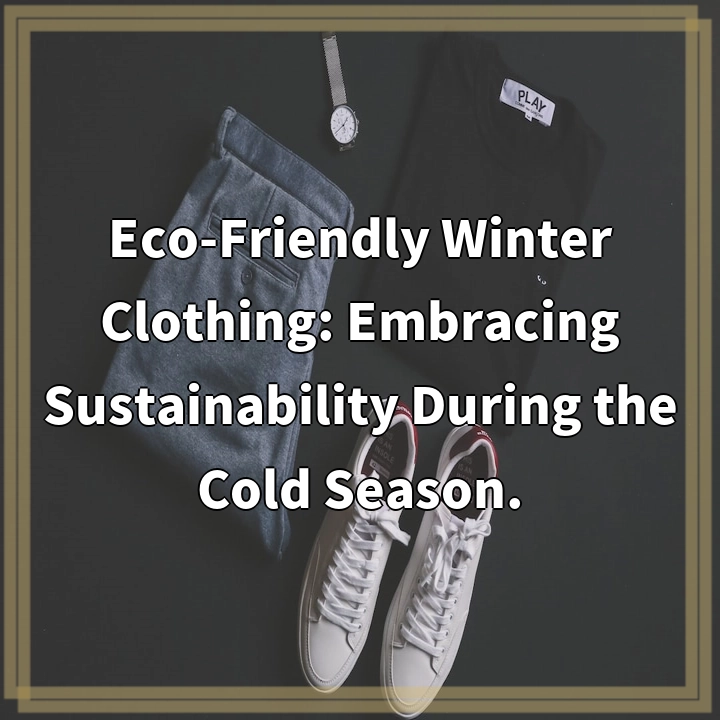
What is Eco-Friendly Winter Clothing?
Eco-friendly winter clothing, also known as sustainable winter wear, refers to garments and accessories that are designed and produced with a focus on reducing their environmental impact. This type of clothing takes into consideration the entire lifecycle of the product, from sourcing materials to manufacturing, usage, and disposal.
Eco-friendly winter clothing typically prioritizes the use of sustainable or recycled materials, such as organic cotton, hemp, recycled polyester, and natural fibers like wool or bamboo. It also involves incorporating environmentally friendly manufacturing processes, reducing water and energy consumption, and minimizing waste and pollution.
Real-World Problems Associated with Eco-Friendly Winter Clothing
Although eco-friendly winter clothing is a step towards more sustainable fashion choices, it faces certain challenges and limitations in the real world. Here are some of the problems associated with it:
1. Limited Availability
Compared to conventional winter clothing options, eco-friendly alternatives may have limited availability in mainstream retail stores. Finding a wide range of sustainable winter wear options can be challenging, especially in certain regions where sustainable fashion is still emerging.
2. Higher Price Point
Eco-friendly winter clothing often comes with a higher price tag due to factors such as the use of organic or recycled materials, ethical labor practices, and sustainable production processes. This can make it less accessible for individuals on a tight budget, limiting the adoption of sustainable winter wear.
3. Performance and Durability
Some eco-friendly winter clothing options may face challenges in terms of performance and durability compared to their conventional counterparts. For example, natural fibers like wool or cotton might not provide the same level of warmth or water resistance as synthetic materials. However, advancements in sustainable textile technology are continuously addressing these issues.
4. Lack of Standards and Transparency
There is still a lack of standardized certifications and clear labeling for eco-friendly winter clothing. This can make it challenging for consumers to differentiate between genuine sustainable products and those with misleading or vague claims. Lack of transparency in the fashion industry also adds to this problem.
5. Consumer Awareness and Education
Many consumers are still unaware of the environmental impact of conventional winter clothing and the advantages of choosing sustainable alternatives. Education and awareness are essential in driving demand for eco-friendly winter wear and encouraging consumers to make more conscious choices.

Solutions for Eco-Friendly Winter Clothing
While there are challenges associated with eco-friendly winter clothing, there are also solutions to overcome them and promote sustainable fashion choices. Here are some solutions:
1. Increasing Availability
Efforts are being made to increase the availability of eco-friendly winter clothing. Sustainable fashion brands are emerging, both online and offline, offering a wider range of options for consumers. Supporting these brands and advocating for sustainable fashion can help create a demand that encourages more retailers to stock sustainable winter wear.
2. Addressing Affordability
To address the issue of higher price points, it is important to consider the long-term benefits and value of eco-friendly winter clothing. Investing in high-quality sustainable garments can provide durability and reduce the need for frequent replacements. Additionally, purchasing second-hand clothing or participating in clothing swaps can offer more affordable alternatives.
3. Improving Performance and Durability
Research and development in sustainable textile technology continue to improve the performance and durability of eco-friendly winter clothing. Innovations in materials and production processes aim to provide warmth, water resistance, and other desirable features without compromising sustainability.
4. Creating Standards and Transparency
Establishing clear and standardized certifications for eco-friendly winter clothing can help consumers make informed choices. Labels and certifications, such as Global Organic Textile Standard (GOTS) or Fair Trade, provide transparency and assurance of sustainable practices. Supporting transparency initiatives in the fashion industry can also contribute to greater accountability.
5. Consumer Education and Awareness
Increasing consumer awareness about the environmental impact of conventional winter clothing is crucial. Educating consumers about the benefits of eco-friendly options, the harmful effects of fast fashion, and the importance of supporting sustainable brands can drive demand for sustainable winter wear. Promoting sustainability through media, social platforms, and educational campaigns can play a significant role in raising awareness.















